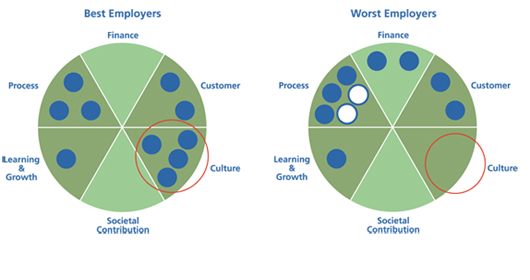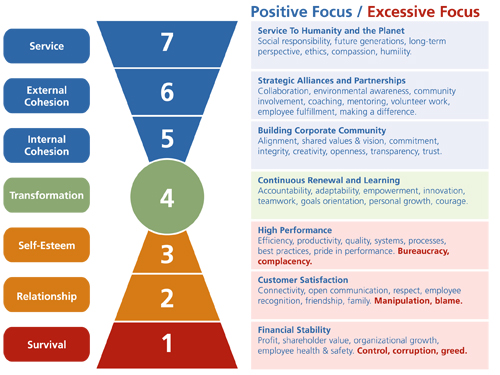Cultural Capital – The Root of Organizational Success
By Cathy Fulton, CHRP
So, where does HR stand? Times are turbulent, change is here to stay and organizations must be engaging and high performing. Easy, right? Not quite.
Despite best efforts, employee engagement strategies often fail to net the desired results. Recent research explains that while engagement is critical, it’s only part of the solution. Organizational culture is reportedly the root to success and should demand most of our attention.
The Business Case for Culture
Research shows that the highest performing organizations in the world pay a lot of attention to their organizational culture. Studies by Jim Collins and Jerry Porras, as outlined in the books Built to Last and Good to Great, show how companies that consistently focused on building strong corporate cultures over a period of several decades outperformed companies that did not – by a factor of six – and outperformed the general stock market by a factor of 15. These companies gave 26 per cent of their time and attention to culture, more than any other category.
In the book, Firms of Endearment, Raj Sisodia, Jag Sheth and David Wolfe, describe how the best companies in the world consider their corporate culture to be their greatest asset and primary source of competitive advantage. These companies outperformed the S&P 500 by an 8:1 ratio over a ten year period ending June 2006.
A 2008 Best Employer Study carried out by Hewitt Associates and the Barrett Values Centre also confirmed that cultural performance is a lead indicator of organizational performance. Their research demonstrated that the best employers considered culture their top value, while the worst employers gave no priority to culture.
In the same study, Hewitt and Barrett also discovered that while employee engagement is very important, culture drives employee engagement. So simply focusing on employee engagement is not enough. Corporate culture must also be consciously managed, to ensure it provides the appropriate foundation for positive engagement and strong organizational performance to occur.
Cultural Capital – The Next Frontier of Competitive Advantage
The impact of culture on organizational performance is powerful. So powerful, Richard Barrett believes it has triggered a new stage in our organizational evolution – the Consciousness Age. With it, our focus has shifted from intellectual to human and now cultural capital. Much as human capital evolved from intellectual capital and encompassed a broader, more holistic perspective of the talent within organizations, cultural capital is more highly evolved again. Cultural capital recognizes the whole system; the system in which our human capital collectively engages and operates.
Culture Defined
But what exactly is culture? Simply put, organizational culture can be defined as the way things are done around here. Edgar Schein, a guru on the topic, describes culture as a pattern of behaviours driven by values, assumptions and beliefs that have worked well enough for the group to perceive them as the right way to think, feel and act. In essence, culture is exhibited in the multiple decisions, conversations, routines, processes, structures and practices that take place between members of an organization on a daily basis. These collective patterns, consciously or unconsciously, make up the “real” working culture of an organization.
Characteristics of a High Performance Culture
So what makes a high performing culture? Well, with the rate of change, complexity and increased expectations on organizations today, a level of agility, resilience, adaptiveness and responsiveness – to all stakeholders – is required as never before.
Unprecedented issues driven by global economic instability, terrorism, natural disasters, corporate disasters, climate change and environmental uncertainty, to name a few, are stretching systems and people beyond anything experienced in the past. We can no longer accurately predict the road ahead and expect a 3-5 year map will effectively guide us forward.
Achieving business goals amidst this uncertainty and complexity takes the collective wisdom and talents of everyone associated with the organization and their ability to collaborate, innovate and accelerate through the constant tide of challenges and opportunities presented. To quote Einstein, “the significant problems we face cannot be solved at the same level of thinking that created them”.
Key Success Factors
A key cultural differentiator that separates highly successful organizations from the rest of the pack is their belief in more than just profit. In recent years, we’ve seen a flood of thought leaders, business leaders, researchers, authors, and academic institutions urging us for something more than a one dimensional focus on bottom line results. We’ve been challenged to think more holistically and encouraged to adopt models with Balanced Score Cards, Triple Bottom Lines, Full Spectrum Leadership, Values Based Leadership… and the list goes on.
Jim Collins and Jerry Porras said it nicely in Built to Last. They said it’s about the “genius of the AND”….and not the “tyranny of the OR” that often pushes leaders to believe things must be either A or B, but not both.
In Firms of Endearment, the authors hail the need for a SPICE stakeholder model where society, partners, investors, customers, and employees are each considered important in their own right and given equal attention, understanding that the whole is better than the parts.
Tony Hsieh, CEO of the highly successful Zappos on-line shoe store, writes in his 2010 book on Delivering Happiness: A Path to Profits, Passion and Purpose about how his focus on developing a tribe of like-minded employees, suppliers and strategic partners was a critical factor in achieving organizational financial success and, perhaps even more importantly to him, organizational happiness.
Gone are the days when the company can over focus on one ideology or one stakeholder. And gone also are the days of entitlement wherein shareholders, customers, leaders and employees focus exclusively on their own self interests. None of these models are sustainable. The new model must be grounded in mutually beneficial relationships between the organization and its stakeholders. In essence, the tribe must be in service to each other with cultural norms and behaviours that are aligned and reflective of their common interests and values.
How Culture is Created – The Value Chain
Alignment of stakeholder values is critical because, as Richard Barrett states, values drive culture, culture drives employee engagement, employee engagement drives service excellence, service excellence drives customer satisfaction and customer satisfaction drives stakeholder value.
Zappos.com certainly concurs with this thinking and as a result, they give a great deal of focus to looking for people whose personal values match their corporate values. CEO Hsieh is very open about wanting people on his team who “just naturally live the Zappos brand whether they are in the office or off the clock”. In fact, he believes that people who don’t fit the company culture are better off being paid to leave …and sooner than later. At the end of their first week of training, all new recruits are offered compensation for the time already spent in training plus a bonus of $2,000 to quit immediately. According to Hsieh, this weeds out those whose values are not aligned and supports the integrity of Zappos’ culture.
HR’s Call to Action – Consciously Creating Your Culture
HR and OD have a huge responsibility to help the organization focus on and consciously create its desired culture. They must build the organization’s literacy around culture and help determine whether the culture and supporting systems, programs and processes are congruent with each other and in alignment with the vision, values and interests of all stakeholders.
First Steps in Getting Started
Understanding your organizational culture is a key first step. There are many tools on the market that can help you assess your culture and determine its effectiveness. One model I really like was developed by Richard Barrett from the Barrett Values Center. It’s full spectrum and clearly demonstrates the degree of stakeholder alignment and cultural function/dysfunction in the organization.
But, whatever model you use, ensure it:
- is easy to use and understand;
- takes a full spectrum/full systems approach;
- measures alignment of stakeholder values; and
- involves your employees (and other stakeholders as much as possible) in the cultural assessment and transformation initiatives that may follow.
Just remember that helping your organization create strong cultural capital is, arguably, the most important thing HR can do!
Cathy Fulton, MA, CHRP is a Senior Consultant with The Intersol Group (www.intersol.ca), where she enjoys helping organizations create workplace cultures that provide winning conditions for success and generate breakthrough results. Cathy offers consulting and facilitation services in organizational development and effectiveness through Intersol’s Western Regional Office in Victoria, BC.
(PeopleTalk: Spring 2012)








